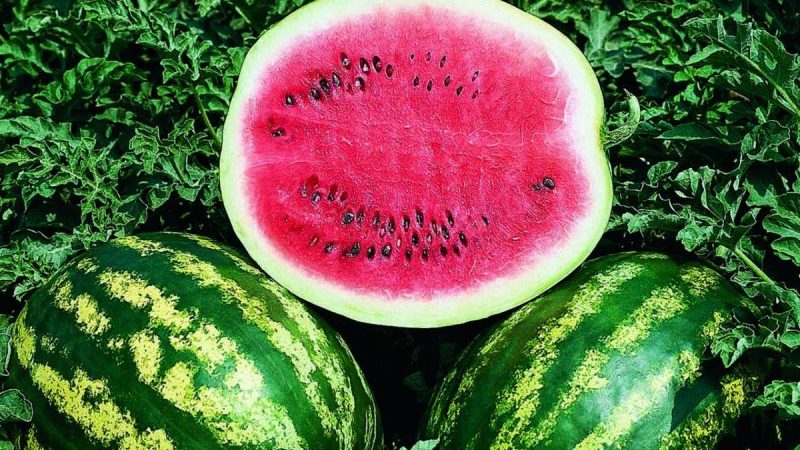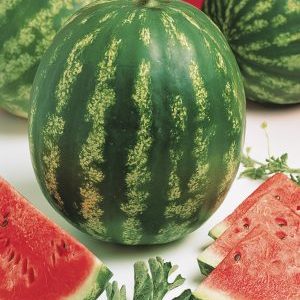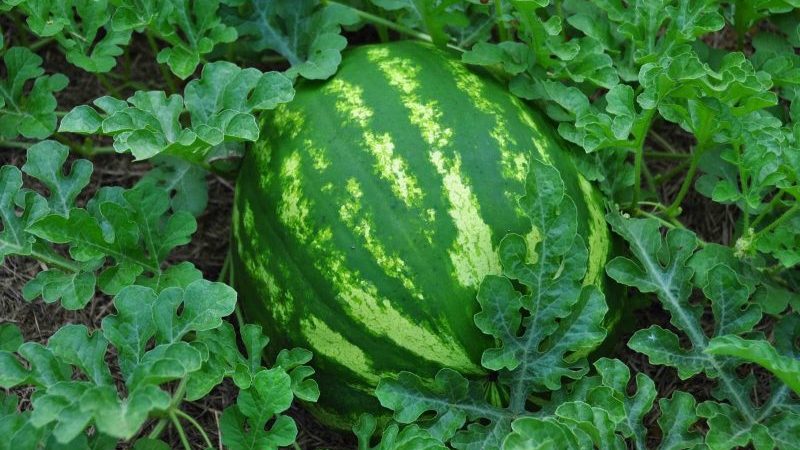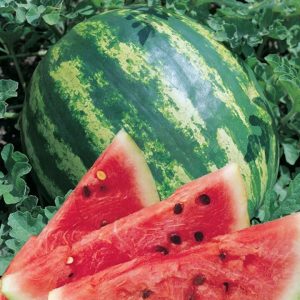Popular variety of watermelon "Krimson Sweet": an overview of the advantages, disadvantages and growing technology
Among garden crops, watermelons are not the most common in most of Russia. However, grow this berry every gardener can do it.
The Crimson Sweet variety has proven itself perfectly in the Russian climate. To enjoy its sugar pink-red flesh, you need to know how to grow it and what are the basic rules for caring for it.
The content of the article
Description of the watermelon variety
Crimson Sweet is a variety that was bred in 1963 and got its name (literally - “Raspberry Sweet”) because of its especially sweet and tender pulp.
The original seeds are distributed in Europe through the Clos Tezier company. The variety was so successful that other varieties and hybrids were developed on its basis: the Crimson Wonder variety and the Crimson Ruby F1 hybrid.

Distinctive features
One of the most important distinguishing features of the variety is its early maturity. From the moment of sowing to harvest, 70-80 days pass.
Reference! The early ripening of fruits is explained by the fact that in such plants flowers are visible already on 4-6 leaves. In varieties of later ripening, flowers are visible only from 12 or even 15 leaves.
The variety prefers a warm climate in which it will grow well and give an excellent harvest without seedlings. However, it is possible to grow Crimson Sweet in less suitable cold climates. In this case, the watermelons should be grown in a greenhouse.
Composition, properties, benefits, calories
Watermelon is not only sweet and delicious, but also beneficial. The juicy pulp of the fruit contains:
- vitamins A, E, group B, as well as PP, D, C;
- folic acid;
- riboflavin;
- thiamine;
- pyridoxine;
- zinc;
- potassium;
- iron;
- calcium;
- copper;
- carotene.
These beneficial substances help to improve metabolic processes in the body, cleanse the bile ducts, prevent the formation of kidney stones due to the pronounced diuretic properties of the berry.
Reference. Watermelon is a low-calorie product. It has only 30 calories per 100 g of pulp. This is a great dessert for those who follow the figure, but cannot deny themselves sweetness.
Specifications
The berries grow round, slightly elongated along. The skin of the fruit is dense and smooth, has a characteristic striped pattern: light green stripes on a dark green background.
Attention! If the whole complex of agrotechnical measures is observed, the fruit grows in weight from 5 to 12 kg.
Crimson Sweet shows an excellent yield: up to 10 kg of berries are harvested from 1 m² of land. Each seedling is able to bring 3-4 large watermelons.
Watermelon fully justifies its name. A dense and juicy pulp is hidden inside the berry, which has a rich red, appetizing color and no less intense taste. There are almost no transverse veins in the structure of the pulp. The taste of watermelon is sugar-honey, deliciously aromatic.
Seeds of watermelon
Watermelon seeds have, like pulp, a number of useful properties:
- They are high in protein - about 28 g in 100 g of dried seeds.

- The high content of arginine - an amino acid that normalizes blood pressure, reduces the risk of coronary heart disease, has a positive effect on the male reproductive system.
- The amino acids contained in the seeds (lysine, tryptophan and glutamic acid) have a beneficial effect on mental abilities, maintaining a high level of concentration, and reducing fatigue from overexertion.
- Watermelon contains many magnesium, zinc, manganese, copper and iron useful for the nervous system.
- The presence of antioxidants that protect cells from free radicals.
Watermelon seeds are high in calories: 557 kcal per 100 g of dry product.
How to grow this variety yourself
Crimson Sweet can be grown by sowing seeds directly into the open ground or growing seedlings from them. The first option is suitable for warm climates. Sowing is carried out on the basis that each plant will require an area of 1.5x1.5 m, if it is open ground.
If you grow watermelons in a greenhouse, less space will be required: about 0.65x0.65 m. The latter is due to the fact that the whips in greenhouses are tied up, and not laid, as in open ground. In greenhouse conditions, the yield will be less: 1-2 watermelons per plant, and in the open field - about 4.
Growing in stages and care

If you decide to germinate the seeds, then it will take much longer to tinker with the seedlings. But you can harvest the crop a couple of weeks earlier than when landing directly into the open ground.
Seeds are sown on seedlings in late April - very early May. Use loose, breathable soil. Seeds are sown in holes up to 1 cm deep. In order for seedlings to appear as early as possible, the planted seeds are kept in greenhouse conditions.
Important! For the appearance of the first shoots, the variety needs to maintain the temperature at 25-30 ° C. Otherwise, it will take a long time to wait for seedlings.
Before planting, the seedlings are hardened, gradually reducing the ambient temperature to + 10 ° C. First, young plants are taken out into the open air for 1-2 hours, then this time is increased.
The planting of plants on the site is carried out approximately 4 weeks after the appearance of the first shoots.
Important! The land for planting must warm up to at least 15 ° C, otherwise the roots of the plant will not be able to develop normally and will die.
Further care consists in:
- Proper watering. When the ovaries are formed, the plant should be watered 2 times a week at the rate of about 3 buckets of water per 1 m². As soon as the fruits appeared, watering should be stopped immediately.
- Timely applied top dressing. It is introduced twice as the culture develops - 2 weeks after planting watermelons in open ground and during the formation of ovaries.
As a fertilizer, slurry or chicken manure, which has been soaked in water, is applied. Superphosphate and potassium chloride are added to the resulting slurry. During re-feeding, mineral fertilizers are applied.
Features of cultivation and possible difficulties
The main features of the variety:
- Photophilousness. Staying in the shade, the fruits will not be able to pick up sweets or will stop growing altogether. Plants should be completely exposed to light from all directions.
- Thermophilicity. The variety will grow and gain sweetness only in dry, warm weather. The temperature range should be between 20 and 25 ° C.
- Dislike for fertile, black earth, as well as heavy peat lands. It will be difficult for a plant to break through such dense soil.
- The introduction of an excessive amount of organic fertilizers into the soil contributes to the growth of green mass... For this reason, the plant has little or no strength for the development of fruits.
- After the fruit has formed, do not water the plants. Otherwise, you run the risk of changing the sugar flavor of the berry to a watery one.
- Sensitivity to mineral fertilizers. With a lack of them, the fruit will form worse in the watermelon, and their taste will noticeably deteriorate.
Diseases and pests characteristic of the variety
The cultivar is insensitive to some diseases typical of pumpkin seeds, for example, fusarium. However, there are pests that can negate the investment.
One of the most common is the common crow, which gets to the berries before you. To fight birds, a scarecrow is installed in the garden.

Among the diseases affecting the variety, the following are worth noting:
- White rot... The disease is promoted by high humidity, frequent and abrupt weather changes.As a result, the watermelons stop growing, the fruits cannot develop normally. Copper sulfate is used to fight the disease.
- Black rot... Watermelons are infected with this fungal disease through insects. To get rid of black rot, remove all affected areas, weed the earth and shed it with copper chloride.
- Powdery mildew... It looks like a whitish bloom on plants. You can get rid of if diseased plants are uprooted and burned, and the soil is treated with "Karatan".
- Anthracnose. Expressed in the presence of brownish spots on the leaves and fruits. To combat it, weeding is carried out, and the plants are treated with Bordeaux essence and a solution of cuprozan.
- Root rot. If the plants are affected by this disease, they are completely removed. This is the only way to preserve healthy specimens of watermelons.
Harvesting and application of the crop
Determining the time of harvest is not so difficult: the stalk of the watermelon begins to dry out. The whiskers and leaves of the fruit also dry out, signaling the onset of maturity. Another sign of maturity is the size of the fruit: the larger it is, the more ripe the berry is. A fully ripe watermelon cracks easily if scratched.
Attention! In ripe watermelon, the crust becomes uniformly glossy and shiny. A yellow spot appears at the point of contact of the fruit with the ground.
If you do not plan to use the crop immediately, but leave it for storage, harvest the fruits only in dry weather.
Important! Store watermelons in a dark, cool room with high humidity. Periodically, the fruits are examined, rejecting spoiled specimens.
Crop use options:

- fresh, by treating family and friends with a treat;
- leave for storage for up to 2 months, observing all the necessary conditions;
- salt unripe watermelons;
- make jam from watermelon peels.
Advantages and disadvantages of the variety
The variety has the following advantages:
- high yield, which more than pays for the effort spent on care;
- excellent transportability - during transportation, the watermelon does not suffer either outside or inside;
- calmly tolerates dry weather, is able to grow and develop with irregular watering;
- high sugar content;
- immunity to a number of typical pumpkin diseases.
Disadvantages of the variety:
- possible watery taste with excessively frequent watering;
- an excess of nitrogen fertilizers affects the rapid growth of green mass, while the fruits become small.
Reviews
Unusual fruits for a cool climate are planted with interest by gardeners at their dachas. Everyone has extremely positive impressions of the work done and the harvest.
Olga, Omsk: “I plant this variety on a regular basis: I can only say positive things about it. I sprout seeds. After landing in the ground, it is imperative to monitor the temperature, if it is cloudy, you should cover the plants. As soon as the fruits grow (at least up to 15 cm in diameter), I stop "insulating" them. The collected fruits are sweet, the seeds fully ripen and turn black. "
Slava, Voronezh: “I have been growing Crimson Sweet for a long time. It is a pleasure to grow such watermelons in the garden. It ripens very early, you can treat everyone with a sweet dessert. The pulp is tender, juicy, and refreshes perfectly in the heat. "
Alex, Pushkino: “I grew seedlings from the purchased seeds in a greenhouse. Then I transplanted her to the beds, I didn't even cover the top with anything. Small watermelons have grown: without any chemicals. The color of the fruit is bright. The watermelon itself is juicy, pink-red and crispy inside. "
Conclusion
Choosing tender, sugar Crimson Sweet, you will certainly delight yourself and your family with an excellent dessert right from the garden. Carrying out simple plant care measures, you will definitely get excellent, large specimens of this berry. The high yield of the variety and its long-term preservation compensate for the efforts spent on care.